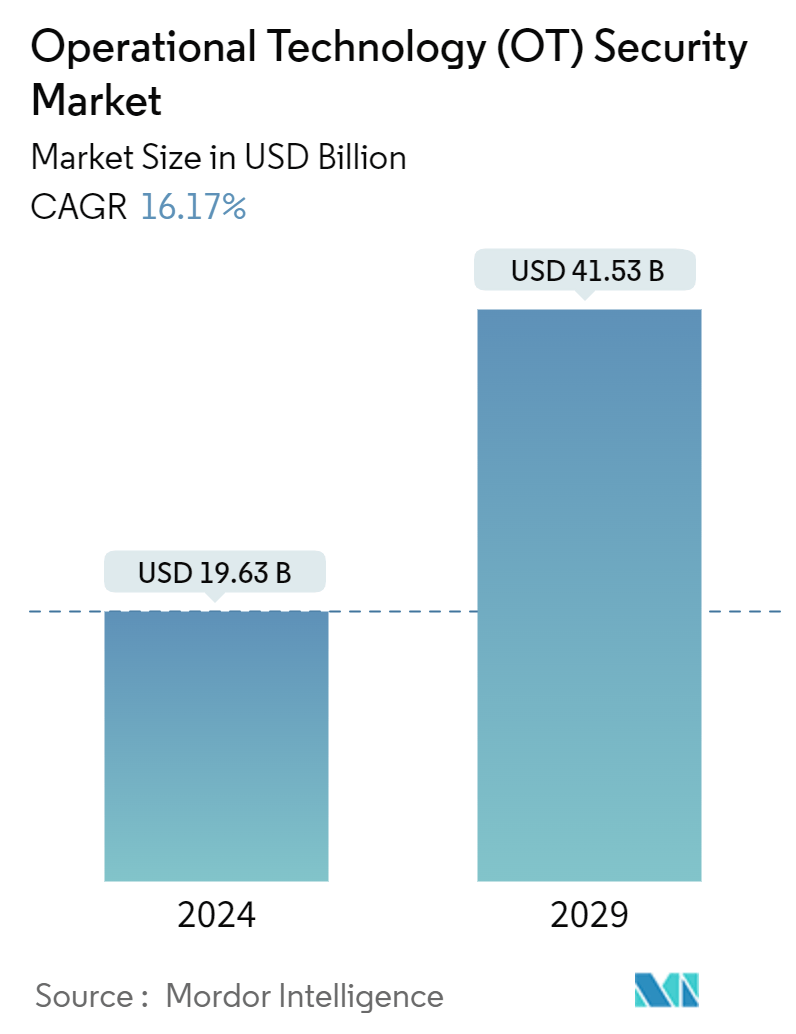Market Size of Operational Technology (OT) Security Industry

| Study Period | 2019 - 2029 |
| Market Size (2024) | USD 19.63 Billion |
| Market Size (2029) | USD 41.53 Billion |
| CAGR (2024 - 2029) | 16.17 % |
| Fastest Growing Market | Asia Pacific |
| Largest Market | North America |
Major Players.webp)
*Disclaimer: Major Players sorted in no particular order |
Operational Technology (OT) Security Market Analysis
The Operational Technology Security Market size is estimated at USD 19.63 billion in 2024, and is expected to reach USD 41.53 billion by 2029, growing at a CAGR of 16.17% during the forecast period (2024-2029).
Operational technology encompasses the tools and practices designed to safeguard assets and information, oversee the workforce, and monitor or control physical devices and processes. These technologies can also trigger changes in enterprise OT systems. Solutions for OT security span a diverse array of technologies, including next-generation firewalls, security information and event management systems, and identity access management.
- Given the significance of maintaining industrial process continuity, the value of trade secrets, and the public safety implications of compromising critical infrastructure, both organized crime and state-sponsored entities are increasingly targeting industrial organizations and critical infrastructure. These actors see them as profitable avenues for financial gain, espionage, or cyberwarfare. Consequently, it is imperative for industrial enterprises to embrace innovative strategies and technologies to protect their business secrets, assets, and digital infrastructure.
- Modern industrial control systems have transitioned from traditional physical setups to incorporating IT capabilities, sometimes replacing or enhancing physical controls. Many of these systems, now internet-connected, face vulnerabilities akin to those of any other online system. Consequently, safeguarding these industrial products and manufacturing systems has become imperative to ensure safe start-stop procedures, stable operations, and optimal performance in industrial production.
- With large-scale, continuous, and highly parameterized industrial devices, the need for industrial automation systems continually increases, leading to notable investments in advanced industrial automation and robotics solutions. According to the International Federation of Robotics (IFR), the annual installation of industrial robots is anticipated to reach 718,000 units globally by 2026, from 400,000 units in 2017. As control systems are widely used to support automated and robotic infrastructure, such trends create a favorable ecosystem for the market's growth.
- The surge in connected sensors, IoT devices, and controllers within industrial network infrastructures has heightened security challenges in recent years. This trend has compelled industrial enterprises to channel investments into advanced security solutions. In response to these escalating security concerns, market vendors are rolling out innovative solutions to safeguard industrial infrastructures from cyberattacks. This proactive approach fosters an environment conducive to market expansion. For example, in April 2024, Industrial Defender, known for its operational technology (OT) asset data and cybersecurity solutions tailored for industrial entities, unveiled 'Phoenix,' a cutting-edge OT security solution specifically crafted to cater to the needs of small-to-medium-sized businesses (SMBs).
- However, factors such as the complexity of implementing OT security systems and the high initial cost involved are among the major challenges for the market’s growth. For instance, a support infrastructure such as high-speed connectivity, information and communication networks, and a skilled workforce are required to adopt advanced security solutions, which requires significant investment. This slows down the adoption of OT security solutions, especially in the small and medium business segments.
- Macroeconomic factors significantly influence the evolution of the examined market. For example, the ongoing geopolitical tensions, particularly in Europe and the United States—stemming from disputes like the US-China trade war and the Russia-Ukraine conflict—heighten the risk of cyberattacks. This escalation compels businesses to channel investments into sophisticated security solutions.

